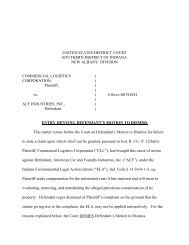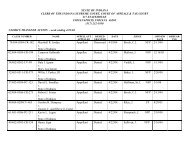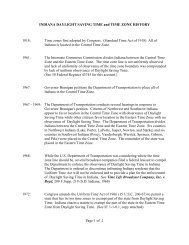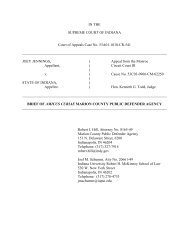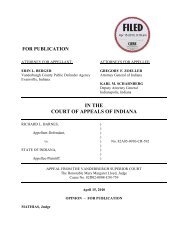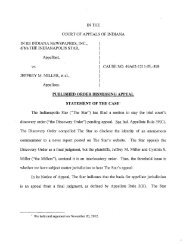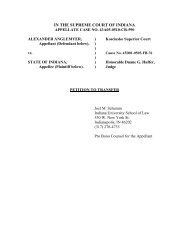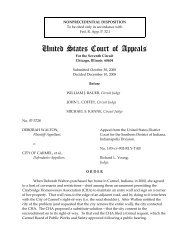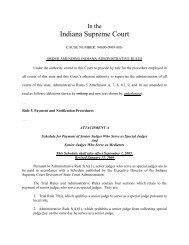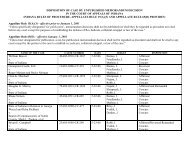the Dec. 18th Order (1507) - The Indiana Law Blog
the Dec. 18th Order (1507) - The Indiana Law Blog
the Dec. 18th Order (1507) - The Indiana Law Blog
You also want an ePaper? Increase the reach of your titles
YUMPU automatically turns print PDFs into web optimized ePapers that Google loves.
Case 1:99-cv-01693-LJM-JMS Document <strong>1507</strong> Filed 12/18/2008 Page 1 of 29<br />
UNITED STATES DISTRICT COURT<br />
SOUTHERN DISTRICT OF INDIANA<br />
INDIANAPOLIS DIVISION<br />
UNITED STATES OF AMERICA,<br />
Plaintiff,<br />
STATE OF NEW YORK, STATE OF NEW<br />
JERSEY, STATE OF CONNECTICUT,<br />
HOOSIER ENVIRONMENTAL COUNCIL,<br />
and OHIO ENVIRONMENTAL COUNCIL,<br />
Plaintiff-Intervenors,<br />
vs.<br />
)<br />
CINERGY CORP., PSI ENERGY, INC., and)<br />
THE CINCINNATI GAS & ELECTRIC )<br />
COMPANY,<br />
)<br />
Defendants.<br />
)<br />
)<br />
)<br />
)<br />
)<br />
)<br />
)<br />
)<br />
)<br />
) FILED UNDER SEAL<br />
) 1:99-cv-1693-LJM-JMS<br />
ORDER ON PLAINTIFFS’ MOTION FOR NEW TRIAL<br />
This cause is before <strong>the</strong> Court on plaintiff’s, <strong>the</strong> United States of America, and<br />
plaintiff-intervenors’, <strong>the</strong> State of New York, <strong>the</strong> State of New Jersey, <strong>the</strong> State of<br />
Connecticut, <strong>the</strong> Hoosier Environmental Council, and <strong>the</strong> Ohio Environmental Council (all<br />
plaintiffs, collectively, “Plaintiffs”), Motion for a New Trial Due to Party Misconduct, or, in<br />
<strong>the</strong> Alternative, for Expedited Discovery and an Evidentiary Hearing. Plaintiffs contend that<br />
pursuant to Federal Rule of Civil Procedure 59 (“Rule 59”) <strong>the</strong>y are entitled to a new trial<br />
on defendants’, Cinergy Corp., PSI Energy, Inc., and <strong>the</strong> Cincinnati Gas & Electric<br />
Company (collectively, “Cinergy”), liability for violations of <strong>the</strong> New Source Recovery<br />
(“NSR”) provisions of <strong>the</strong> Clean Air Act (“CAA”), at certain Cinergy facilities. Plaintiffs<br />
assert that under a signed consulting agreement (<strong>the</strong> “Agreement”), which was not<br />
disclosed to Plaintiffs prior to <strong>the</strong> liability trial, Cinergy promised to pay fact witness Robert
Case 1:99-cv-01693-LJM-JMS Document <strong>1507</strong> Filed 12/18/2008 Page 2 of 29<br />
Batdorf (“Batdorf”), $200.00 per hour for his testimony at that trial. Plaintiffs contend that<br />
<strong>the</strong> agreement was responsive to at least one discovery request and, in addition, that this<br />
amount is above that necessary to reasonably compensate Batdorf for “lost time.”<br />
Moreover, Cinergy misled <strong>the</strong> jury and <strong>the</strong> Court when it contrasted Plaintiffs’ paid expert<br />
witnesses’ testimony with that of Cinergy’s unpaid current and former employees, including<br />
Batdorf, numerous times during <strong>the</strong> liability trial. All of <strong>the</strong>se facts, Plaintiffs argue,<br />
prejudiced Plaintiffs and may have effected <strong>the</strong> outcome of <strong>the</strong> liability trial. As a result,<br />
Plaintiffs request a new trial on liability.<br />
In contrast, Cinergy asserts that Plaintiffs’ failure to discover <strong>the</strong> Agreement or to<br />
properly cross-examine Batdorf at trial led to <strong>the</strong> jury’s verdict. Fur<strong>the</strong>rmore, Cinergy<br />
contends that $200.00 per hour is reasonable compensation to Batdorf for lost time. Even<br />
if <strong>the</strong> Court disagrees with Cinergy about Plaintiffs’ responsibility for properly examining<br />
Batdorf at trial or about <strong>the</strong> nature of <strong>the</strong> Agreement, Cinergy contends that <strong>the</strong> content of<br />
<strong>the</strong> Agreement and/or <strong>the</strong> fact that Batdorf was paid merely goes to Batdorf’s credibility,<br />
which is insufficient reason to order a new trial.<br />
For <strong>the</strong> reasons stated herein, <strong>the</strong> Court GRANTS Plaintiffs’ Motion for a New Trial.<br />
I. FACTUAL & PROCEDURAL BACKGROUND<br />
<strong>The</strong> United States of America (“USA”) initiated this lawsuit against Cinergy alleging,<br />
inter alia, that Cinergy violated <strong>the</strong> NSR 1 provisions of <strong>the</strong> CAA when it made physical<br />
changes to units at various power plants that constitute “major modifications” as defined<br />
1<br />
NSR includes both <strong>the</strong> Prevention of Significant Deterioration (“PSD”)<br />
provisions and <strong>the</strong> Nonattainment New Source Review (“NNSR”) provisions.<br />
2
Case 1:99-cv-01693-LJM-JMS Document <strong>1507</strong> Filed 12/18/2008 Page 3 of 29<br />
by <strong>the</strong> CAA. A major modification consists of any physical change that would result in a<br />
significant net emissions increase of a pollutant covered by <strong>the</strong> CAA. See 40 C.F.R. §<br />
52.21. USA contends that Cinergy was required to obtain permits for installing pollution<br />
controls as required by <strong>the</strong> NSR provisions of <strong>the</strong> CAA prior to modifying its plants. <strong>The</strong><br />
states of New York, New Jersey, and Connecticut, along with <strong>the</strong> Hoosier Environmental<br />
Council and <strong>the</strong> Ohio Environmental Council, intervened and joined in this lawsuit.<br />
Batdorf was employed by Cinergy and its predecessor companies for thirty-four<br />
years. (Trial Tr. at 1291-96.) Eventually, Batdorf became station manager at <strong>the</strong> Wabash<br />
River, Cayuga, and Gibson power plants. (Id.) By 2005, Batdorf had retired. (Batdorf July<br />
6, 2005, Dep. at 6.) At no time did Cinergy offer Batdorf as an expert witness in this case.<br />
(Docket No. 1257, Cinergy Witness List, Apr. 14, 2008.) Ra<strong>the</strong>r, Cinergy offered Batdorf<br />
as a fact witness. (Id.)<br />
Pursuant to <strong>the</strong> Case Management Plan in this cause, in Phase I of <strong>the</strong> case, in May<br />
2008, <strong>the</strong> parties tried <strong>the</strong> issues of liability to a jury. Specifically, <strong>the</strong> Court and <strong>the</strong> parties<br />
asked <strong>the</strong> jury to assess Cinergy’s liability for violation of <strong>the</strong> NSR provisions of <strong>the</strong> CAA<br />
for <strong>the</strong> following projects: condensor retubing at Beckjord unit 5 from January 1991 to<br />
February 1991; condensor retubing at Beckjord unit 6 from September 1994 to November<br />
1994; replacement of <strong>the</strong> front wall radiant superheater at Wabash River unit 2 from June<br />
1989 to July 1989; replacement of <strong>the</strong> high temperature finishing superheater tubes and<br />
upper reheater tubing assemblies at Wabash River unit 2 from May 1992 to September<br />
1992; replacement of <strong>the</strong> finishing, intermediate, and radiant superheater tubes and upper<br />
reheat tube bundles at Wabash River unit 3 from June 1989 to October 1989; replacement<br />
of <strong>the</strong> boiler pass and heat recovery actions at Wabash River unit 5 from February 1990<br />
3
Case 1:99-cv-01693-LJM-JMS Document <strong>1507</strong> Filed 12/18/2008 Page 4 of 29<br />
to May 1990; life extension project at Beckjord unit 1 from November 1987 to February<br />
1988; life extension project at Beckjord unit 2 from October 1987 to January 1988; life<br />
extension project at Beckjord unit 3 from October 1985 to January 1986. Replacement of<br />
<strong>the</strong> pulverizers at Gallagher unit 1 from April 1998 to July 1998; condensor retubing at<br />
Gallagher unit 2 from August 1990 to <strong>Dec</strong>ember 1990; replacement of <strong>the</strong> pulverizers at<br />
Gallagher unit 3 from February 1999 to April 1999; replacement of <strong>the</strong> reheater tube<br />
section at Gibson unit 2 from February 2001 to May 2001; and replacement of <strong>the</strong> slope<br />
tubes and lower headers at Miami Fort unit 5, January 1995 to March 1995.<br />
At trial, Cinergy pressed a <strong>the</strong>me that included positioning its fact witnesses as<br />
ordinary working men who were more trustworthy and believable than Plaintiffs’ paid expert<br />
witnesses. For example, in its opening statement, Cinergy stated: “During <strong>the</strong> years<br />
covered by this case, <strong>the</strong> people that were making <strong>the</strong> predictions for Cinergy were its<br />
engineers, not hired experts; and <strong>the</strong>y were our engineers because <strong>the</strong>y were <strong>the</strong> people<br />
most familiar with <strong>the</strong> company’s generation units and <strong>the</strong> repair projects that were about<br />
to take place.” (Trial Tr. at 67.)<br />
Consistent with that <strong>the</strong>me, Cinergy closely examined each of Plantiffs’ expert<br />
witnesses regarding <strong>the</strong>ir compensation. Specifically, Cinergy asked Mike Hekking<br />
(“Hekking”) if his only paying work over <strong>the</strong> last ten years had been as an expert testifying<br />
on behalf of <strong>the</strong> U.S. Department of Justice (“USDOJ”) and Environmental Protection<br />
Agency (“EPA”). (Id. at 375-76.) Cinergy’s cross-examination of Hekking continued in <strong>the</strong><br />
same vein:<br />
Q<br />
Now, sir, I need to ask you this. I presume that you’ve been<br />
compensated for your efforts, have you not?<br />
4
Case 1:99-cv-01693-LJM-JMS Document <strong>1507</strong> Filed 12/18/2008 Page 5 of 29<br />
A<br />
Q<br />
A<br />
Q<br />
Yes.<br />
Can you tell us <strong>the</strong> total amount of <strong>the</strong> compensation you’ve received<br />
since <strong>the</strong> time you went to work for <strong>the</strong> Government in this endeavor<br />
up and through today?<br />
No.<br />
Well, can you give me an estimate?<br />
* * *<br />
A<br />
I would say on <strong>the</strong> order of $250,000. No more than that.<br />
(Id. at 427-28.)<br />
Similarly, Robert Koppe (“Koppe”), ano<strong>the</strong>r Plaintiffs’ expert who testified on <strong>the</strong><br />
effects of major component replacement on unit availability, was asked: “So your<br />
methodology for predicting an increase in availability now linked with what we are going to<br />
hear from Dr. [Richard] Rosen [(“Dr. Rosen”)], an increase in emissions, that’s never been<br />
done before, before you came to work for <strong>the</strong> Government, right?” (Id. at 738.) And, Dr.<br />
Rosen was asked, “Well, when you were first hired in this case to give your opinion, you<br />
discovered that <strong>the</strong> NSR rules didn’t require any particular methodology or formula to make<br />
a prediction or to analyze whe<strong>the</strong>r emissions will increase; isn’t that correct?” (Id. at 1008.)<br />
Cinergy repeated this point with respect to Dr. Rosen’s testimony when it asked: “Before<br />
you were hired in this case, you had never given any opinion on <strong>the</strong> applicability of NSR<br />
or any o<strong>the</strong>r environmental regulation to a utility; isn’t that correct?” (Id. at 1010.)<br />
At <strong>the</strong> conclusion of Cinergy’s cross-examination of Dr. Rosen, <strong>the</strong> following<br />
discussion about compensation ensued:<br />
Q<br />
And you can confirm for us that <strong>the</strong> total amount of payment you or<br />
<strong>the</strong> Tellus Institute has received for your participation in <strong>the</strong> NSR<br />
cases is about $500,000?<br />
5
Case 1:99-cv-01693-LJM-JMS Document <strong>1507</strong> Filed 12/18/2008 Page 6 of 29<br />
A<br />
I would say that’s roughly correct, yes.<br />
Q Could it be more than $500,00?<br />
A<br />
It could be more by now because <strong>the</strong>re are o<strong>the</strong>r cases that I haven’t<br />
appeared in yet that I’m starting to work on. So it could be more, yes.<br />
Q Could it be $600,000?<br />
A<br />
It is a possibility. I really haven’t made an estimate.<br />
Q Could it be $700,000?<br />
A<br />
I don’t think it’s that much yet, no.<br />
(Id. at 1079.)<br />
Notably, Cinergy declined to call any of its expert witnesses to testify at trial; ra<strong>the</strong>r,<br />
it called Batdorf and three current Cinergy employees. (Id. at 1110, 1141, 1291, 1423-24.)<br />
With respect to its examination of Batdorf on direct, Cinergy began with an inquiry into his<br />
current employment status:<br />
Q<br />
A<br />
Q<br />
A<br />
Are you currently employed, Mr. Batdorf?<br />
No, sir, I am currently retired.<br />
Where did you work before you retired?<br />
Immediately prior to my retirement, I worked for <strong>the</strong> Cinergy<br />
Company.<br />
(Id. at 1291.) Cinergy proceeded to inquire about Batdorf’s employment history at Cinergy,<br />
but did not inquire into Batdorf’s post-retirement activities. (Id. at 1291-96.) Likewise,<br />
Plaintiffs did not inquire about Batdorf’s employment activities post-retirement.<br />
During direct examination, Batdorf testified:<br />
Q<br />
If you, sir, generally, and we’ll get to <strong>the</strong> specific projects in a minute,<br />
but if you generally replace something like <strong>the</strong> front wall radiant<br />
6
Case 1:99-cv-01693-LJM-JMS Document <strong>1507</strong> Filed 12/18/2008 Page 7 of 29<br />
superheater tubes, are you going to expect running that unit to have<br />
fewer outages from that component in <strong>the</strong> future?<br />
A<br />
Q<br />
A<br />
Q<br />
A<br />
Q<br />
A<br />
Q<br />
A<br />
Any time we do any project like that, whe<strong>the</strong>r it be <strong>the</strong> radiant<br />
superheater tube or any o<strong>the</strong>r component replacement, we fully<br />
expect that we will have less tube leaks in that section that was<br />
replaced.<br />
Is that always true?<br />
Most times; but like anything, <strong>the</strong>re’s always exceptions.<br />
When you replace a component or a section of <strong>the</strong> tubes in <strong>the</strong> boiler,<br />
to what extent did you expect fewer outages from <strong>the</strong> unit over <strong>the</strong><br />
next two years?<br />
We didn’t. <strong>The</strong> fact that we replaced a component did not cause us<br />
to expect any difference in <strong>the</strong> performance of that unit. All’s we did<br />
was address one component. <strong>The</strong>re’s too many o<strong>the</strong>r factors that<br />
influence <strong>the</strong> unit.<br />
Well, if you didn’t expect an increase in unit availability when you<br />
replace a component like front wall radiant superheater tubes, why do<br />
you spend <strong>the</strong> money and <strong>the</strong> time to do those pro[jects]?<br />
We spent <strong>the</strong> money to do those projects in an effort to maintain <strong>the</strong><br />
availability of that unit.<br />
Did you believe, based on your 31 years of experience, when you<br />
were approving and supervising <strong>the</strong>se projects, that it was possible to<br />
predict <strong>the</strong> number or extent of forced outages that would occur in <strong>the</strong><br />
two years after you replaced a component or a number of<br />
components?<br />
No, sir. Forced outages are random, unexpected events. You have<br />
no idea when <strong>the</strong>y’re going to occur or what <strong>the</strong> duration will be; and<br />
I have 34 years of experience.<br />
(Id. at 1322-23.)<br />
7
Case 1:99-cv-01693-LJM-JMS Document <strong>1507</strong> Filed 12/18/2008 Page 8 of 29<br />
In addition, Batdorf testified generally about <strong>the</strong> purpose of Plaintiffs’ Exhibit 1592.<br />
Plaintiffs’ Exhibit 1592 was PSI Energy’s 2<br />
“Instruction Project Evaluation Guide” (<strong>the</strong><br />
“Cinergy Project Evaluation Guide”), dated March 1, 2999. (Id. at 915.) Dr. Rosen, one<br />
of Plaintiffs’ experts, explained to <strong>the</strong> jury <strong>the</strong> model contained <strong>the</strong>rein for evaluating <strong>the</strong><br />
costs and benefits of a proposed project. (Id. at 915-22.) Dr. Rosen opined that <strong>the</strong><br />
method in <strong>the</strong> Cinergy Project Evaluation Guide for calculating “generation” was <strong>the</strong> same<br />
as his method for calculating “generation,” which substantiated Dr. Rosen’s formula for<br />
calculating emissions. (Id. at 925.)<br />
However, Batdorf testified that <strong>the</strong> purpose of <strong>the</strong> guide was only to evaluate a<br />
project’s economics, not to calculate a unit’s predicted future generation. (Id. at 1363-64.)<br />
Specifically, Batdorf testified:<br />
Q<br />
A<br />
Q<br />
A<br />
If we walked through this guide and looked page by page, would we<br />
find anything related to using <strong>the</strong>se project evaluation tools to predict<br />
or plan unit operations for future generation?<br />
No, sir. It would be using <strong>the</strong> guide for purposes o<strong>the</strong>r than what it<br />
was intended. It was strictly to do <strong>the</strong> economic evaluation, nothing<br />
to do with future predictions.<br />
And to what extent, if any, do <strong>the</strong> cost/benefit analysis or project<br />
evaluations done with this guide fold into <strong>the</strong> rankings we just saw?<br />
That’s what leads to <strong>the</strong> ranking process.<br />
(Id. at 1363-64.).<br />
When Batdorf left <strong>the</strong> stand after his testimony and while <strong>the</strong> jury was present,<br />
Cinergy inquired of <strong>the</strong> Court: “Mr. Batdorf, I assume because he’s retired, would like to<br />
2<br />
<strong>The</strong>re is no dispute that Cinergy utilized this model to evaluate projects. (Trial<br />
Tr. at 1363-64.)<br />
8
Case 1:99-cv-01693-LJM-JMS Document <strong>1507</strong> Filed 12/18/2008 Page 9 of 29<br />
know if he could sit in <strong>the</strong> courtroom and observe <strong>the</strong> proceedings going forward?” (Id. at<br />
1423.) Plaintiffs did not object; <strong>the</strong> Court responded, “No problem.” (Id.) Batdorf sat in <strong>the</strong><br />
gallery for <strong>the</strong> rest of <strong>the</strong> trial.<br />
Again, consistent with its opening statement and its examination of witnesses during<br />
trial, Cinergy returned to its <strong>the</strong>me of paid versus unpaid witness testimony at <strong>the</strong><br />
beginning of its closing argument:<br />
<strong>The</strong> case really does come down to two different versions of <strong>the</strong><br />
world. It would not be clearer, and it could not have been clearer in<br />
[Plaintiffs’] opening statement. <strong>The</strong> [Plaintiffs’] view of <strong>the</strong> world is one that<br />
is built on after <strong>the</strong> fact, artificial formulas, expert testimony paid for and<br />
brought to you in this courtroom.<br />
We didn’t rely on experts. We brought you <strong>the</strong> men who made <strong>the</strong>se<br />
decisions in real time to sit in this witness stand and to tell you <strong>the</strong> process<br />
<strong>the</strong>y followed and what <strong>the</strong>y thought.<br />
* * *<br />
Here are a few o<strong>the</strong>r things we know about [Plaintiffs’ experts’<br />
formula] besides <strong>the</strong> history of its creation. We know it’s never been used<br />
outside this and similar lawsuits. We know it’s never been recommended or<br />
supported by anybody who wasn’t a paid Government expert.<br />
(Id. at 1525, 1529.) It fur<strong>the</strong>r highlighted this <strong>the</strong>me later in its closing argument:<br />
Let’s talk about <strong>the</strong> real world for a minute. Let’s talk about Bob<br />
Batdorf and Barry Pulskamp. <strong>The</strong> longest witnesses we put on <strong>the</strong> stand<br />
which I hope were not too long by comparison were Bob Batdorf and Barry<br />
Pulskamp. <strong>The</strong>y didn’t come to you with advanced degrees in physics. <strong>The</strong>y<br />
didn’t come to you with presentation graphics that had 6-foot high<br />
boilermakers. <strong>The</strong>y didn’t come to you with formulas.<br />
All <strong>the</strong>y did is come to <strong>the</strong> stand and tell you, look you in <strong>the</strong> eye and<br />
tell you what <strong>the</strong>y thought, what <strong>the</strong>y expected and what <strong>the</strong>y believed and<br />
what <strong>the</strong>y predicted at <strong>the</strong> time <strong>the</strong>y did <strong>the</strong>se projects.<br />
<strong>The</strong>y told you what <strong>the</strong>y understood and what <strong>the</strong>y believed based on<br />
<strong>the</strong>ir reasonable, common-sense engineering judgment. And contrary to<br />
what you heard from [Plaintiffs’] this morning, <strong>the</strong>y told you <strong>the</strong>re was a<br />
9
Case 1:99-cv-01693-LJM-JMS Document <strong>1507</strong> Filed 12/18/2008 Page 10 of 29<br />
process in place. No one was ignoring <strong>the</strong> law. No one was pretending to<br />
be above <strong>the</strong> law. <strong>The</strong>y were making good-faith judgments. And Mr. Batdorf<br />
told you if he had a question, he called <strong>the</strong> environmental engineers. If he<br />
had a question, he called <strong>the</strong> [S]tate of <strong>Indiana</strong>.<br />
That is not a bad-faith approach. That is a reasonable, commonsense,<br />
good-faith approach to this issue. <strong>The</strong>y admitted to you <strong>the</strong>y didn’t<br />
write it down. He admitted to you he didn’t do a memo to <strong>the</strong> file. If<br />
[Plaintiffs] had a rule that said do a memo to <strong>the</strong> file, you can be assured Bob<br />
Batdof would have done a memo to <strong>the</strong> file. So would Barry Pulskamp.<br />
<strong>The</strong>y told you about some cases where <strong>the</strong>y thought <strong>the</strong>re might be<br />
an emissions increase where <strong>the</strong>y got an NSR permit because <strong>the</strong>y looked<br />
at <strong>the</strong> project that was proposed and <strong>the</strong>y said, “Wait a minute. That might<br />
change capacity. It might change functionality. It might change how <strong>the</strong> unit<br />
will be operated in <strong>the</strong> future. We better get some people involved here. We<br />
better actually do a calculation and take a closer look.”<br />
And when <strong>the</strong>re was a reasonable view that a project would result in<br />
an increase in emissions, <strong>the</strong>y got an NSF permit. Where <strong>the</strong>re wasn’t, <strong>the</strong>y<br />
didn’t do formulas. <strong>The</strong>y didn’t do calculations. <strong>The</strong>y proceeded under <strong>the</strong>ir<br />
process and under <strong>the</strong>ir reasonable judgment.<br />
Reasonable is <strong>the</strong> byword here. If you’re not changing anything about<br />
unit operations, if you’re not changing <strong>the</strong> capacity of <strong>the</strong> boiler, it’s tubes in,<br />
tubes out. You can mock that phrase if you want to; but it reflects a<br />
common-sense, real-world judgment that whe<strong>the</strong>r <strong>the</strong> front reheater tubes<br />
are old or whe<strong>the</strong>r <strong>the</strong> front reheater tubes are new and shiny doesn’t cause<br />
emissions from <strong>the</strong> unit.<br />
You also heard <strong>the</strong> following things from Mr. Batdorf and Mr.<br />
Pulskamp: <strong>The</strong>y told you that based on <strong>the</strong>ir long experience and <strong>the</strong>ir realworld<br />
view, you cannot predict and <strong>the</strong>y didn’t predict that changes to a<br />
single component would impact <strong>the</strong> availability of <strong>the</strong> unit.<br />
I already showed you <strong>the</strong> availability of degraders. You heard Mr.<br />
Batdorf talk about Excedrin Headache 57 or 58 or 59 or whatever one it was.<br />
That was a reasonable way of approaching <strong>the</strong>se predictions.<br />
(Id. at 1551-53.)<br />
On May 22, 2008, <strong>the</strong> jury returned a verdict in favor of Plaintiffs on four of <strong>the</strong><br />
fourteen alleged NSR violations at <strong>the</strong> Wabash River plant, and a verdict in favor of<br />
10
Case 1:99-cv-01693-LJM-JMS Document <strong>1507</strong> Filed 12/18/2008 Page 11 of 29<br />
Cinergy on <strong>the</strong> ten remaining claims at Cinergy’s o<strong>the</strong>r coal-fired power plants. (Docket<br />
No. 1339, Verdict Form.)<br />
No judgment has entered on <strong>the</strong> jury’s verdict.<br />
<strong>The</strong>reafter, <strong>the</strong> parties proceeded with discovery on Phase II, or <strong>the</strong> remedy phase,<br />
of <strong>the</strong> case. During <strong>the</strong> remedy phase discovery period, on its initial witness list, Cinergy<br />
listed Batdorf as a former employee and potential fact witness. (Docket No. 1391.)<br />
Subsequently, Cinergy listed Batdorf on three o<strong>the</strong>r witness lists, including a list of its “Top<br />
10” fact witnesses. (Pls.’ Ex. 7; Pls.’ Ex. 8; Pls.’ Ex. 9.) In addition, Cinergy proffered<br />
dates for Batdorf’s deposition, like it had for its o<strong>the</strong>r “Top 10” fact witnesses. (Pls.’ Ex.<br />
10.)<br />
Fur<strong>the</strong>r, Plaintiffs’ Second Set of Requests for Production of Documents in Remedy<br />
Phase of Case, Requests No. 1, 9, 10, and 12, served on Cinergy on August 15, 2008,<br />
requested all documents relating to “compensation” of former employees who were on<br />
Cinergy’s witness lists, including consulting contracts, billing records, and invoices relating<br />
to payment of such witnesses. (Pls.’ Ex. 11.) In its response to this discovery request,<br />
dated September 18, 2008, Cinergy stated: “Subject to and without waiving any of <strong>the</strong>se<br />
objections, Cinergy responds that, to date, no witnesses o<strong>the</strong>r than expert witnesses are<br />
being compensated for testimony related to <strong>the</strong> remedy phase of this case.” (Pls.’ Ex. 12,<br />
at 11).<br />
In <strong>the</strong> mean time, Cinergy refused to provide Plaintiffs with contact information for<br />
Batdorf claiming that he was under contract with Cinergy, as a consultant; <strong>the</strong>refore,<br />
Plaintiffs must contact Batdorf through counsel. Specifically, Cinergy responded: “With<br />
respect to Mr. Batdorf, he is a former Cinergy employee who consults with Cinergy on a<br />
11
Case 1:99-cv-01693-LJM-JMS Document <strong>1507</strong> Filed 12/18/2008 Page 12 of 29<br />
variety of matters related to his prior employment with <strong>the</strong> company. He has asked that<br />
any contacts with him be made through Cinergy counsel.” (Pls.’ Ex. 13.) At that point,<br />
Plaintiffs requested a copy of Batdorf’s consulting agreement or agreements, if more than<br />
one existed. (Pls.’ Ex. 14.) By letter dated September 22, 2008, Cinergy agreed to<br />
produce responsive documents. (Pls.’ Ex. 15.)<br />
During a September 30, 2008, phone call, Cinergy informed Plaintiffs that it was<br />
withdrawing Batdorf from all witness lists and that, <strong>the</strong>refore, all discovery related to him<br />
would be irrelevant. 3<br />
(Pls.’ Ex. 16.) Plaintiffs disputed Cinergy’s view of <strong>the</strong> relevance of<br />
Batdorf’s consulting agreement, in part, because “[h]e was one of a handful of Cinergy<br />
witnesses at <strong>the</strong> liability trial and <strong>the</strong> only one with personal knowledge about <strong>the</strong><br />
operations at <strong>the</strong> Wabash River plant.” (Id.) Plaintiffs also disputed Cinergy’s view, in part,<br />
because Cinergy’s witness lists would not control <strong>the</strong> appropriate discovery in <strong>the</strong> remedy<br />
phase. (Id.) In response, Cinergy stated: “In light of <strong>the</strong> revisions to our witness list<br />
(served earlier today [October 2, 2008]), Cinergy has no responsive documents to<br />
produce.” (Pls.’ Ex. 18.)<br />
Immediately upon receiving Cinergy’s response, Plaintiffs notified Cinergy of <strong>the</strong>ir<br />
intent to file a motion to compel <strong>the</strong> next day. (Pls.’ Ex. 19.) On <strong>the</strong> same day, Cinergy<br />
provided a copy of Batdorf’s consulting agreement to Plaintiffs, but refused o<strong>the</strong>r discovery<br />
on <strong>the</strong> issue. (Pls.’s Ex. 20.) Plaintiffs responded:<br />
Cinergy has not produced all of <strong>the</strong> responsive information regarding<br />
Cinergy/Duke’s consulting contract for Mr. Batdorf “for advice and live<br />
testimony” in this case. Please produce <strong>the</strong> invoices, billing records, and any<br />
3<br />
Cinergy did, in fact, remove Batdorf from its remedy phase witness list on<br />
October 2, 2008. (Pls.’ Ex. 17.)<br />
12
Case 1:99-cv-01693-LJM-JMS Document <strong>1507</strong> Filed 12/18/2008 Page 13 of 29<br />
o<strong>the</strong>r documents relating to <strong>the</strong> payment of Mr. Batdorf under this consulting<br />
agreement. If [Plaintiffs] do not have a copy of <strong>the</strong> requested documents by<br />
9:00 am tomorrow, we will file our motion to compel to obtain <strong>the</strong> balance of<br />
<strong>the</strong> responsive information.<br />
(Id.) In response, Cinergy indicated that it would produce <strong>the</strong> requested documents on or<br />
before Monday, October 6, 2008. (Pls.’ Ex. 22.) However, by letter dated October 6, 2008,<br />
Cinergy stated:<br />
After careful consideration of your request for <strong>the</strong> production of Batdorf<br />
compensation documents and fur<strong>the</strong>r consultation with <strong>the</strong> client, Cinergy<br />
has determined that it will not produce any additional documents concerning<br />
Mr. Batdorf’s compensation, nor will it produce Mr. Batdorf for a deposition<br />
in this case.<br />
(Pls.’ Ex. 23.)<br />
By letter dated October 14, 2008, Plaintiffs informed Cinergy’s counsel, in part, that:<br />
On October 2, Cinegy produced an agreement between Cinergy’s<br />
parent, Duke Energy, and Cinergy to pay Mr. Robert Batdorf $200 per hour<br />
for his “live testimony” at <strong>the</strong> liability trial and <strong>the</strong> time spent providing<br />
“advice” in this case. This agreement was not previously disclosed in <strong>the</strong><br />
liability phase. Indeed, <strong>the</strong> agreement was signed only a month before <strong>the</strong><br />
liability trial, well after <strong>the</strong> discovery cut off in that phase of <strong>the</strong> case.<br />
You subsequently promised in writing to produce on October 6 <strong>the</strong><br />
billing invoices and records regarding <strong>the</strong> Batdorf agreement. When that<br />
deadline arrived, however, you informed me that Cinergy would not be<br />
producing that information, and it would not produce Mr. Batdorf for<br />
deposition.<br />
We have now had <strong>the</strong> benefit of reviewing, analyzing and deliberating<br />
upon <strong>the</strong>se unusual circumstances, including <strong>the</strong> fact that Duke Energy<br />
contracted to pay an hourly rate to a fact witness, Mr. Batdorf, that exceeds<br />
<strong>the</strong> rate paid to several experts in this case. We believe <strong>the</strong>se<br />
circumstances raise substantial questions regarding <strong>the</strong> fairness and integrity<br />
of <strong>the</strong> liability trial. We also continue to believe that this discovery is relevant<br />
to <strong>the</strong> remedy phase.<br />
To that end, if all billing records, invoices, and o<strong>the</strong>r documents<br />
relating to <strong>the</strong> agreement are not produced immediately – and witnesses,<br />
such as Mr. Batdorf, made available for deposition – on Thursday, October<br />
13
Case 1:99-cv-01693-LJM-JMS Document <strong>1507</strong> Filed 12/18/2008 Page 14 of 29<br />
16, <strong>the</strong> United States will file a motion to compel discovery relating to <strong>the</strong>se<br />
issues, including <strong>the</strong> billing records and invoices under <strong>the</strong> agreement with<br />
Mr. Batdorf, Mr. Batdorf’s deposition, and <strong>the</strong> deposition of persons with<br />
knowledge of any payments to Mr. Batdorf by Cinergy, or its parent, Duke<br />
Energy.<br />
(Pls.’ Ex. 24 (emphasis added by Plaintiffs).)<br />
(Pls.’ Ex. 2.)<br />
wrote:<br />
By letter dated October 15, 2008, Cinergy replied:<br />
As previously indicated, none of <strong>the</strong> information that you seek through<br />
document production or deposition is responsive to any discovery request in<br />
<strong>the</strong> remedy phase, and none of <strong>the</strong> information was sought by Plaintiffs –<br />
through formal discovery or cross-examination – during <strong>the</strong> liability phase.<br />
Moreover, as we have explained, Cinergy will not call Mr. Batdorf as a<br />
witness at <strong>the</strong> remedy trial. In addition, Mr. Batdorf has not provided any<br />
advice to Cinergy in connection with <strong>the</strong> remedy phase of this case nor been<br />
consulted with respect to any fact or legal aspect of <strong>the</strong> remedy phase. For<br />
all of <strong>the</strong>se reasons, <strong>the</strong> discovery you seek is not relevant to <strong>the</strong> remedy<br />
phase of this case or likely to lead to <strong>the</strong> discovery of admissible evidence<br />
at trial in <strong>Dec</strong>ember.<br />
Likewise, <strong>the</strong> information which Plaintiffs request has no relevance to <strong>the</strong><br />
liability phase of this case, which conclude in May. Contrary to your<br />
suggestion, an employee’s compensation, or former employee’s<br />
compensation, as part of a consulting agreement does not raise questions<br />
about <strong>the</strong> fairness of <strong>the</strong> liability proceedings. Indeed, <strong>the</strong>re is nothing<br />
controversial about a consulting agreement for a highly trained former<br />
employee like Mr. Batdorf. Moreover, to <strong>the</strong> extent that Plaintiffs were<br />
interested in Bob Batdorf’s compensation (or <strong>the</strong> compensation of any o<strong>the</strong>r<br />
witness called during <strong>the</strong> liability trial), Plaintiffs’ counsel were free to explore<br />
those issues on cross-examination. Presumably, Plaintiffs’ counsel made<br />
<strong>the</strong> strategic decision not to so inquire. Regardless, no discovery request<br />
during <strong>the</strong> liability phase called for <strong>the</strong> disclosure of current or former<br />
employee compensation, and Plaintiffs never sought to elicit such<br />
information from Mr. Batdorf during any of his six depositions or at trial. <strong>The</strong><br />
record for <strong>the</strong> liability phase is now closed, and that is <strong>the</strong> end of <strong>the</strong> matter.<br />
By email, also dated October 15, 2008, Cinergy’s counsel Frank R. Volpe (“Volpe”)<br />
14
Case 1:99-cv-01693-LJM-JMS Document <strong>1507</strong> Filed 12/18/2008 Page 15 of 29<br />
(Pls.’ Ex. 4.)<br />
I have been reading <strong>the</strong> correspondence related to discovery on Mr.<br />
Batdorf’s consultancy agreement and I am sure you have now read Katie<br />
Thompson’s responding letter sent earlier tonight.<br />
I must confess that I am quite surprised that you continue to pursue this<br />
irrelevant issue. I am fur<strong>the</strong>r surprised that you have decided to interject<br />
rhetoric calling into question <strong>the</strong> fairness and integrity of <strong>the</strong> liability trial<br />
based on this nonissue. But you have and you now seem determined to file<br />
some sort of motion. That is, of course, your prerogative. I write separately<br />
only to add that if you do file a motion seeking fur<strong>the</strong>r discovery of this issue,<br />
it had better be supported with some authority. <strong>The</strong> fact that, in hindsight,<br />
you want to second-guess <strong>the</strong> strategic judgments of Plaintiffs’ experienced<br />
trial team not to question witnesses in a certain matter on certain topics is not<br />
authority. Please consider this our notice under Rule 11 and Rule 26(g) that<br />
any such unsupported pleading will be met with a request for sanctions.<br />
In later correspondence, Cinergy indicated to Plaintiffs that it would accept service<br />
on behalf of Mr. Batdorf only if <strong>the</strong> Court granted Plaintiffs’ Motion to Compel. (Pls.’ Ex.<br />
25.)<br />
<strong>The</strong> content of <strong>the</strong> Agreement is important for purposes of <strong>the</strong> background in this<br />
case. By letter dated April 3, 2008, approximately one month prior to <strong>the</strong> start of <strong>the</strong> trial<br />
on <strong>the</strong> liability issues in this case, Cinergy sent a letter agreement to Batdorf that, in<br />
pertinent part, states <strong>the</strong> following:<br />
I understand that while you were employed by Cinergy and its predecessor<br />
companies, you dealt with issues that are relevant to <strong>the</strong> above-referenced<br />
litigation. Because of your personal knowledge and expertise regarding<br />
those matters, Cinergy Corp. (“Cinergy”) would like to engage you as an<br />
independent consultant in <strong>the</strong> above-referenced litigation. This letter will<br />
evidence our agreement (hereafter referred to as <strong>the</strong> “Agreement”) for <strong>the</strong><br />
provision of those consulting services (<strong>the</strong> “Services”) as an independent<br />
contractor. This Agreement will remain in effect until <strong>Dec</strong>ember 31, 2008,<br />
unless extended by written agreement between you and Cinergy or unless<br />
terminated sooner as provided below.<br />
During <strong>the</strong> term of this Agreement, you agree to provide such time to perform<br />
<strong>the</strong> Services as may be reasonably requested by Cinergy. You will be<br />
15
Case 1:99-cv-01693-LJM-JMS Document <strong>1507</strong> Filed 12/18/2008 Page 16 of 29<br />
required to provide advice and live testimony in <strong>the</strong> above-referenced<br />
litigation. Cinergy will provide you with reasonable advance notice of any<br />
hearing, trial or o<strong>the</strong>r proceeding that may require your attendance and you<br />
agree to assist Cinergy in adequately preparing for and attending such<br />
proceedings as requested. In performing your consulting services under this<br />
Agreement, you will receive assignments from Dean Moesser, Julie Ezell<br />
and/or <strong>the</strong>ir designees, which shall include outside counsel at <strong>the</strong> Sidley &<br />
Austin law firm in Washington D.C.<br />
You will be paid $200 per hour for time spent in performance of <strong>the</strong> Services<br />
contemplated herein. . . . In addition, you will be reimbursed for any and all<br />
actual reasonable expenses incurred by you in connection with <strong>the</strong> Services<br />
rendered hereunder. . . .<br />
. . . You will provide [Cinergy] with an invoice on at least a quarterly basis<br />
detailing <strong>the</strong> number of hours you have provided Services. Such invoice<br />
shall also detail reimbursable reasonable expenses, if any, incurred by you<br />
in connection with <strong>the</strong> Services rendered during such period, including, but<br />
not limited to, business travel, hotel accommodations, and meals . . . .<br />
. . . It is understood and agreed that you will be an independent contractor<br />
ra<strong>the</strong>r than an employee, servant, or agent of Cinergy or any of its affiliates<br />
in <strong>the</strong> performance of <strong>the</strong> Services undertaken to be performed hereunder<br />
and you will have <strong>the</strong> authority and responsibility to select <strong>the</strong> means,<br />
manner, and method of performing <strong>the</strong> obligations assumed hereunder,<br />
provided that such means, manner, and methods comply with all federal,<br />
state, and local laws, rules, and regulations and conform with Cinergy’s rules<br />
and policies that are now or may be in <strong>the</strong> future become applicable to <strong>the</strong><br />
performance of Services under this Agreement or <strong>the</strong> business practices of<br />
those who act on behalf of or perform services for Cinergy. You will be<br />
responsible for payment of all taxes, including federal, state, and local taxes<br />
arising out of your activities under this Agreement, including but not limited<br />
to, income tax, social security tax, and unemployment insurance tax that<br />
might be due.<br />
* * *<br />
Unless or until a conflict arises, a Cinergy attorney or its outside legal<br />
counsel will act as your attorney in any proceeding relating to this<br />
engagement. . . .<br />
* * *<br />
This Agreement constitutes and expresses <strong>the</strong> complete understanding<br />
of <strong>the</strong> parties hereto and <strong>the</strong>re are no understandings or commitments<br />
16
Case 1:99-cv-01693-LJM-JMS Document <strong>1507</strong> Filed 12/18/2008 Page 17 of 29<br />
not expressly stated herein. No revision, modification or amendment<br />
of this Agreement shall be valid unless in writing and signed by both<br />
parties <strong>the</strong>reto. None of <strong>the</strong> rights or obligations of this Agreement may<br />
be assigned without prior written consent of <strong>the</strong> non-assigning parting.<br />
<strong>The</strong> Agreement shall be governed and construed in accordance with<br />
<strong>the</strong> laws of <strong>the</strong> State of Texas.<br />
(Pls.’ Ex. 1 (emphasis in original).) <strong>The</strong> letter is signed by Dean Moesser (“Moesser”) on<br />
behalf of Cinergy; Batdorf signed and dated <strong>the</strong> Agreement on April 7, 2008, which, by its<br />
terms, made <strong>the</strong> Agreement effective on April 7, 2008. (Id.)<br />
II. DISCUSSION<br />
Plaintiffs contend that Cinergy’s failure to disclose that it had a consulting agreement<br />
with Batdorf, its misrepresentation of Batdorf’s relationship to Cinergy during <strong>the</strong> trial, and<br />
its reliance on this misrepresentation as a key strategy in its defense rendered <strong>the</strong> liability<br />
trial unfair.<br />
Cinergy argues that Plaintiffs bore <strong>the</strong> burden of discovering <strong>the</strong> Batdorf agreement<br />
at trial and <strong>the</strong>ir failure to properly question Batdorf about potential sources of bias is <strong>the</strong>ir<br />
own responsibility. In o<strong>the</strong>r words, Cinergy committed no error in failing to disclose <strong>the</strong><br />
Agreement, or in allowing Batdorf and its lawyers to create <strong>the</strong> impression at trial that<br />
Batdorf was retired. Even if <strong>the</strong> Court disagrees with Cinergy’s assessment of its<br />
responsibilities vis-a-vis disclosure of <strong>the</strong> Agreement, Cinergy asserts that <strong>the</strong> only<br />
relevance of <strong>the</strong> Batdorf agreement at <strong>the</strong> liability trial would have been to impeach<br />
Batdorf, which has never been grounds for a new trial.<br />
17
Case 1:99-cv-01693-LJM-JMS Document <strong>1507</strong> Filed 12/18/2008 Page 18 of 29<br />
Generally, a motion for a new trial on <strong>the</strong> grounds of misconduct of <strong>the</strong> opposing<br />
party is brought pursuant to Rule 60(b)(3) and not Rule 59(a). 4<br />
See Lonsdorf v. Seefeldt,<br />
47 F.3d 893, 896-97 (7 th Cir. 1995) (discussing a motion under Rule 59(a) under an<br />
evidentiary standard and a motion under Rule 60(b)(3) under a misconduct standard); but<br />
see Wharf v. Burlington N.R. Co., 60 F.3d 631, 637 (9 th Cir. 1995) (stating that “[t]he<br />
standards for granting new trials are essentially <strong>the</strong> same under both rules, although a Rule<br />
59 motion, because it may be made within [ten] days, may require a slightly lower showing<br />
than a motion under Rule 60”). <strong>The</strong> distinction is an important one to Cinergy because it<br />
contends that Plaintiffs cannot meet <strong>the</strong> clear and convincing standard of proof appropriate<br />
for motions under Rule 60(b)(3). <strong>The</strong> Seventh Circuit has not specifically addressed <strong>the</strong><br />
issue of what standard might apply to a party’s claim under Rule 59(a) that misconduct of<br />
<strong>the</strong> o<strong>the</strong>r party is grounds for a new trial; however, <strong>the</strong> Court concludes that it does not<br />
matter in this case which burden of proof applies because Plaintiffs have ample evidence<br />
of misconduct to support <strong>the</strong>ir request for a new trial.<br />
With that in mind, to obtain relief here Plaintiffs “must prove that: (1) [<strong>the</strong>y]<br />
maintained a meritorious claim at trial; and (2) because of <strong>the</strong> fraud, misrepresentation or<br />
misconduct of [Cinergy]; (3) [Plaintiffs were] prevented from fully and fairly presenting<br />
[<strong>the</strong>ir] case at trial.” Lonsdorf, 47 F.3d at 897 (citing Green v. Foley, 856 F.2d 660, 665 (4 th<br />
4 Rule 60(b)(3) states, in pertinent part: “On motion and just terms, <strong>the</strong> court may<br />
relieve a party . . . from a final judgment, order, or proceeding for <strong>the</strong> following reasons:<br />
. . . “fraud . . ., misrepresentation, or misconduct by an opposing party . . . .” Fed. R.<br />
Civ. P. 60(b)(3).<br />
Rule 59(a) states, in pertinent part: “<strong>The</strong> court may . . . grant a new trial on all or<br />
some of <strong>the</strong> issues—and to any party—. . . after a jury trial, for any reason for which a<br />
new trial has heretofore been granted in an action at law in federal court . . . .” Fed. R.<br />
Civ. P. 59(a)(1)(A).<br />
18
Case 1:99-cv-01693-LJM-JMS Document <strong>1507</strong> Filed 12/18/2008 Page 19 of 29<br />
Cir. 1988), cert. denied, 490 U.S. 1031 (1989)). In making its determination, <strong>the</strong> Court<br />
“must weigh <strong>the</strong> competing policy interests of <strong>the</strong> finality of judgment against fundamental<br />
fairness in light of all <strong>the</strong> facts.” 5<br />
Id. (citing Square Constr. Co. v. Wash. Metro. Area<br />
Transit Auth., 657 F.2d 68, 71 (4 th Cir. 1981)). “A determination of whe<strong>the</strong>r <strong>the</strong> alleged<br />
misrepresentation altered <strong>the</strong> result of <strong>the</strong> case is unnecessary because Rule 60(b)(3)<br />
protects <strong>the</strong> fairness of <strong>the</strong> proceedings, not necessarily <strong>the</strong> correctness of <strong>the</strong> verdict.”<br />
Id. (citing Plattner v. Strick Corp., 102 F.R.D. 612, 614 (N.D. Ill. 1984)).<br />
Plaintiffs easily satisfy <strong>the</strong>ir burden to show that <strong>the</strong>y had meritorious claims on <strong>the</strong><br />
projects upon which <strong>the</strong> jury rendered a verdict against <strong>the</strong>m. Plaintiffs used <strong>the</strong> same<br />
experts and <strong>the</strong> same methodology to prove that Cinergy violated <strong>the</strong> NSR provisions of<br />
<strong>the</strong> CAA for all of <strong>the</strong> projects at issue. Plaintiffs’ experts opined that for all of <strong>the</strong> projects<br />
at issue, <strong>the</strong> relevant modifications resulted in a significant net emissions increase of a<br />
pollutant covered by <strong>the</strong> CAA.<br />
Plaintiffs also have satisfied <strong>the</strong>ir burden to show that Cinergy’s failure to disclose<br />
<strong>the</strong> Batdorf agreement, its misrepresentation of Batdorf’s relationship to Cinergy during <strong>the</strong><br />
trial, and its reliance on this misrepresentation as a <strong>the</strong>me during <strong>the</strong> jury trial resulted in<br />
an unfair trial. Cinergy claims that it was Plaintiffs’ responsibility to elicit testimony from<br />
Batdorf at trial to challenge his assertion that he was retired. But, <strong>the</strong> Court is at a loss as<br />
to how Plaintiffs should have known that Batdorf’s answer to <strong>the</strong> question, “Are you<br />
5 <strong>The</strong> Court notes that <strong>the</strong> standard under Rule 59(a) similarly focuses on<br />
whe<strong>the</strong>r <strong>the</strong>re are “o<strong>the</strong>r reasons <strong>the</strong> trial was not fair to <strong>the</strong> moving party.’” Shick v. Ill.<br />
Dep’t of Human Servs., 307 F.3d 605, (7 th Cir. 2002) (quoting Briggs v. Marshall, 93<br />
F.3d 355, 360 (7 th Cir. 1996)) (fur<strong>the</strong>r citation omitted).<br />
19
Case 1:99-cv-01693-LJM-JMS Document <strong>1507</strong> Filed 12/18/2008 Page 20 of 29<br />
currently employed, Mr. Batdorf?,” which was, “No, sir, I am currently retired,” was<br />
incorrect. <strong>The</strong>re had been no disclosure of Batdorf as a paid expert and no attempt by<br />
Cinergy to correct <strong>the</strong> impression left by this testimony that Batdorf was not employed. This<br />
impression was emphasized by Cinergy multiple times. Specifically, Cinergy represented<br />
to <strong>the</strong> Court that Batdorf would like to stay in <strong>the</strong> courtroom, because he was retired, which<br />
clearly implied that he was unemployed, yet interested in <strong>the</strong> outcome of <strong>the</strong> case.<br />
Fur<strong>the</strong>rmore, it was clear that Cinergy’s defense was grounded in a paid versus unpaid<br />
testimony <strong>the</strong>me. <strong>The</strong> second paragraph of Cinergy’s closing argument highlighted <strong>the</strong><br />
<strong>the</strong>me by focusing attention on “two different versions of <strong>the</strong> world . . . .” This <strong>the</strong>me was<br />
only made possible if Cinergy’s witnesses were, in fact, not paid.<br />
<strong>The</strong> existence of <strong>the</strong> Agreement belies Cinergy’s view of <strong>the</strong> world. According to <strong>the</strong><br />
Agreement, at <strong>the</strong> time of trial, Batdorf was self-employed as a consultant for Cinergy on<br />
<strong>the</strong> very matters for which he would testify. In o<strong>the</strong>r words, Batdorf perverted <strong>the</strong> truth<br />
when he answered Cinergy’s direct question about <strong>the</strong> status of his employment. Accord<br />
Paragon Podiatry Lab., Inc. v. KLM Labs., Inc., 984 F.2d 1182, 1191 (Fed. Cir. 1993) (“We<br />
need not quibble about whe<strong>the</strong>r a ‘consultant’ is or is not ‘employed’ by a company. <strong>The</strong><br />
representation to <strong>the</strong> PTO that <strong>the</strong> affiants were not employed presents a classic example<br />
of a half truth, and <strong>the</strong> explanation that <strong>the</strong> [affiants] understood no remuneration was paid<br />
for <strong>the</strong>ir statements is nonresponsive.”). That Batdorf claims he did not intend to mislead<br />
<strong>the</strong> Court is not dispositive because <strong>the</strong> standard under Rule 60(b)(3) “applies to both<br />
intentional and unintentional misrepresentations.” Lonsdorf, 47 F.3d at 897 (citing Plattner<br />
v. Strick Corp., 102 F.R.D. 612, 614 (N.D. Ill. 1984) (relying on a Fifth Circuit case)).<br />
20
Case 1:99-cv-01693-LJM-JMS Document <strong>1507</strong> Filed 12/18/2008 Page 21 of 29<br />
Cinergy’s argument that federal statutes allow for payment of witness fees and that<br />
<strong>the</strong> Agreement was nothing more than a promise to pay such fees is specious. <strong>The</strong><br />
Agreement itself sets forth its purpose: Batdorf was to provide “advice and live testimony”<br />
as assigned by Moesser, Julie Ezell, and/or outside counsel at Sidley & Austin, in<br />
exchange for $200.00 per hour, plus reasonable expenses. (Pls.’ Ex. 1.) <strong>The</strong> relevant<br />
statute and ethical rules that allow for compensation of fact witnesses never contemplated<br />
<strong>the</strong> hiring of a consultant, who is to be directed by <strong>the</strong> party’s counsel, to provide “advice<br />
and live testimony.” Ra<strong>the</strong>r, <strong>the</strong> relevant federal statute allows for reimbursement to a fact<br />
witness “of <strong>the</strong> reasonable cost of travel and subsistence incurred and <strong>the</strong> reasonable<br />
value of time lost in attendance at any such trial, hearing, or proceeding, or in <strong>the</strong> case of<br />
expert witnesses, a reasonable fee for time spent in <strong>the</strong> preparation of such opinion, and<br />
in appearing and testifying.” 18 U.S.C. § 201(d). A $200.00 per hour fee is beyond “<strong>the</strong><br />
reasonable value of time lost” for a person who purports to be “retired.” This is particularly<br />
true when compared to Batdorf’s compensation in a 2005 consultant agreement between<br />
Cinergy and Batdorf in which Batdorf received $88.00 per hour for his services based on<br />
his base salary at <strong>the</strong> time he retired. (Defs.’ Ex. 5, 9, 12.)<br />
Fur<strong>the</strong>rmore, <strong>the</strong> ethical rules state that “[a] lawyer shall not: . . . counsel or assist<br />
a witness to testify falsely, or offer an inducement to a witness that is prohibited by law .<br />
. . .” Ind. R. Prof. Conduct 3.4(b). Here, Cinergy’s counsel may have counseled or<br />
assisted Batdorf to testify falsely about his employment status. At <strong>the</strong> very least, Cinergy’s<br />
lawyers offered an inducement for Batdorf to testify that is beyond that which is<br />
contemplated by 18 U.S.C. § 201(d). Fur<strong>the</strong>rmore, <strong>the</strong> Seventh Circuit has held that<br />
witness compensation agreements are against public policy. Hamilton v. Gen. Motors<br />
21
Case 1:99-cv-01693-LJM-JMS Document <strong>1507</strong> Filed 12/18/2008 Page 22 of 29<br />
Corp., 490 F.2d 223, 229 (7 th Cir. 1973) (discussing <strong>the</strong> predecessor to 18 U.S.C. § 201(d),<br />
18 U.S.C. § 201(j)). According to <strong>the</strong> Hamilton court, allowing payment for fact witness<br />
testimony is against <strong>the</strong> spirit of <strong>the</strong> Constitution to allow citizens to obtain “justice freely<br />
and without being obligated to purchase it.” Id. (quoting Wright v. Somers, 125 Ill. App.<br />
256, 257-58 (1906) (quoting U.S. Const. Sec. 19, Art. II)). <strong>The</strong> Hamilton court also<br />
expressed concern with such practices because <strong>the</strong>y “lean toward <strong>the</strong> procurement of<br />
perjury,” “<strong>the</strong> perversion of justice,” and <strong>the</strong> “corruption in our courts.” Id. (quoting Wright,<br />
125 Ill. App. at 257-58). In addition, <strong>the</strong> Hamilton court stated,<br />
<strong>the</strong> services of non-expert witnesses are not analogous to lawyers or even<br />
to expert witnesses. Inasmuch as <strong>the</strong> kinds and amount of reimbursement<br />
to which such witnesses are entitled are so severely circumscribed . . . [to]<br />
“reasonable cost of travel and subsistence incurred and <strong>the</strong> reasonable value<br />
of time lost in attendance.”<br />
Id. (quoting 18 U.S.C. § 201(j), now codified at 18 U.S.C. § 201(d)). <strong>The</strong> Agreement in <strong>the</strong><br />
instant case cannot be said to have followed this dictate that a party “severely<br />
circumscribe” <strong>the</strong> amount of reimbursement given to a fact witness.<br />
Cinergy claims that <strong>the</strong> existence of <strong>the</strong> Agreement would have merely amounted<br />
to impeachment evidence; however, Cinergy mischaracterizes its reliance on Batdorf’s<br />
status as a “retired” and “unpaid” former employee as a defense <strong>the</strong>me at trial. Cinergy’s<br />
opening statement set <strong>the</strong> stage for a paid versus unpaid testimony <strong>the</strong>me by pointing to<br />
<strong>the</strong> “hired experts” of Plaintiffs and contrasting <strong>the</strong>m with its own “engineer” witnesses.<br />
(Trial Tr. at 67.) It continued this <strong>the</strong>me by allowing Batdorf to testify that he was not<br />
currently employed, knowing that this testimony was at least misleading because <strong>the</strong><br />
Agreement made Batdorf an independent contractor. (Id. at 1291.) Fur<strong>the</strong>rmore, Cinergy<br />
22
Case 1:99-cv-01693-LJM-JMS Document <strong>1507</strong> Filed 12/18/2008 Page 23 of 29<br />
refocused attention on Batdorf’s employment status when it requested that <strong>the</strong> Court allow<br />
Batdorf to remain in <strong>the</strong> courtroom for <strong>the</strong> remainder of <strong>the</strong> trial, “because he’s retired.” (Id.<br />
at 1423.) <strong>The</strong> Court’s grant of <strong>the</strong> request put a gloss of truth on <strong>the</strong> misrepresentation<br />
that Batdorf was retired and reinforced Cingery’s paid experts versus unpaid witnesses<br />
<strong>the</strong>me. By integrating <strong>the</strong> Court into its duplicity about Batdorf’s employment status<br />
Cincery prejudiced <strong>the</strong> fairness of <strong>the</strong> trial.<br />
Moreover, this was not an inconsequential <strong>the</strong>me as Cinergy seems to suggest.<br />
Ra<strong>the</strong>r, it was central to Cinergy’s defense. Cinergy pointed to “two different versions of<br />
<strong>the</strong> world” in its closing argument painting Plaintiffs’ paid expert witnesses’ picture on one<br />
canvas and its “real world” “reasonable, common-sense engineering” men’s picture on <strong>the</strong><br />
o<strong>the</strong>r. 6<br />
This is particularly troubling in light of Batdorf’s testimony regarding, generally, <strong>the</strong><br />
effect of any improvements on unit performance, (Trial Tr. at 1322-23), and regarding,<br />
generally, <strong>the</strong> way engineers at Cinergy used <strong>the</strong> Cinergy Project Evaluation Guide. (Trial<br />
Tr. at 915-25.) Both pieces of testimony were used by Cinergy to contradict Plaintiffs’<br />
experts’ opinions. Fur<strong>the</strong>r, <strong>the</strong> jury verdict was split with respect to <strong>the</strong> specific projects for<br />
which Batdorf provided testimony. <strong>The</strong>refore, it is difficult to determine <strong>the</strong> extent of <strong>the</strong><br />
unfairness in <strong>the</strong> process. Never<strong>the</strong>less, <strong>the</strong> Court agrees with <strong>the</strong> Federal Circuit when<br />
it opined that “[a] litigant who engages in misconduct should ‘not be permitted <strong>the</strong> benefit<br />
of calculation, which can be little better than speculation, as to <strong>the</strong> extent of <strong>the</strong> wrong<br />
inflicted upon his opponent.’” Schrieber Foods, Inc. v. Beatrice Cheese, Inc., 402 F.3d<br />
1198, 1206 (Fed. Cir. 2005) (quoting Fraige v. Am.-Nat’l Watermattress Corp., 996 F.2d<br />
6<br />
Cinergy never said that its witnesses were unpaid; but it clearly implied that its<br />
witnesses were not similarly paid extra like Plaintiffs’ experts.<br />
23
Case 1:99-cv-01693-LJM-JMS Document <strong>1507</strong> Filed 12/18/2008 Page 24 of 29<br />
295, 299 (Fed. Cir. 1993) (quoting Minneapolis, St. Paul & Sault Ste. Marie Ry. Co. v.<br />
Moquin, 283 U.S. 520, 521-22 (1931))) (applying Seventh Circuit law).<br />
Despite Cinergy’s many protestations to <strong>the</strong> contrary, <strong>the</strong> Court concludes that<br />
Cinergy’s failure to disclose <strong>the</strong> Agreement also flies in <strong>the</strong> face of <strong>the</strong> automatic<br />
disclosures required under Rule 26. Under <strong>the</strong> automatic disclosure provision of Rule<br />
26(a)(1)(A) a party is required to “provide to <strong>the</strong> o<strong>the</strong>r parties . . . <strong>the</strong> name, and if known,<br />
<strong>the</strong> address and telephone number of each individual likely to have discoverable<br />
information—along with <strong>the</strong> subjects of that information—that <strong>the</strong> disclosing party may use<br />
to support its claims or defenses, unless <strong>the</strong> use would be solely for impeachment . . . .”<br />
Fur<strong>the</strong>rmore, Rule 26(e) states that<br />
[a] party who has made a disclosure under Rule 26(a)—or who has<br />
responded to an interrogatory, request for production, or request for<br />
admission—must supplement or correct its disclosure or response . . . in a<br />
timely manner if <strong>the</strong> party learns that in some material respect <strong>the</strong> disclosure<br />
or response is incomplete or incorrect, and if <strong>the</strong> additional or corrective<br />
information has not o<strong>the</strong>rwise been made known to <strong>the</strong> o<strong>the</strong>r parties during<br />
<strong>the</strong> discovery process or in writing . . . .<br />
Fed. R. Civ. P. 26(e)(1)(A). Here, Batdorf’s personal information had changed in a material<br />
way on April 7, 2008, when <strong>the</strong> Agreement became effective: he became a witness<br />
represented by counsel. In <strong>the</strong> same way that in <strong>the</strong> remedy phase Cinergy’s counsel<br />
refused to allow Plaintiffs to contact Batdorf unless it was through counsel because of <strong>the</strong><br />
Agreement, Cinergy withheld material information about Batdorf’s new contact information<br />
once <strong>the</strong> Agreement was signed. Cinergy’s disclosure of <strong>the</strong> Agreement in April 2008<br />
surely would have prompted Plaintiffs to request additional discovery on <strong>the</strong> content of <strong>the</strong><br />
Agreement and <strong>the</strong> extent of Batdorf’s services as a “consultant.”<br />
24
Case 1:99-cv-01693-LJM-JMS Document <strong>1507</strong> Filed 12/18/2008 Page 25 of 29<br />
Moreover, it appears to <strong>the</strong> Court that <strong>the</strong> Agreement triggered Cinergy’s obligation<br />
to supplement its discovery under Rule 26(e) for ano<strong>the</strong>r reason: it might lead to<br />
discoverable information regarding Plaintiffs’ document requests regarding communication<br />
between Cinergy and its consultants regarding NSR. (Pls.’ Ex. 28, at 13.) In early<br />
discovery requests in <strong>the</strong> liability phase, <strong>the</strong> United States requested all documents relating<br />
to such communications. <strong>The</strong> Agreement clearly makes Batdorf a consultant. <strong>The</strong>re is no<br />
dispute that Cinergy called Batdorf to testify regarding whe<strong>the</strong>r <strong>the</strong> NSR provisions applied<br />
to Cinergy’s plants and to testify, generally, about <strong>the</strong> applicability of <strong>the</strong> provisions to<br />
Cinergy’s units. It follows, <strong>the</strong>n, that Plaintiffs’ discovery request covered <strong>the</strong> Agreement<br />
because it is a communication about <strong>the</strong> Batdorf’s expertise on <strong>the</strong> relevant subject matter<br />
of <strong>the</strong> law suit: <strong>the</strong> application of <strong>the</strong> NSR provisions to Cinergy’s plants.<br />
In summary, <strong>the</strong> Court concludes that Cinergy’s misrepresentations about payment<br />
of one of its fact witnesses, Batdorf, amounts to misconduct. Because of such misconduct,<br />
<strong>the</strong> liability trial in this matter was tainted and Plaintiffs’ request for a new trial on liability<br />
is GRANTED. <strong>The</strong> Court will issue a separate scheduling order regarding said new trial.<br />
III. CONCLUSION<br />
For <strong>the</strong> reasons stated herein, <strong>the</strong> Court GRANTS plaintiff’s, <strong>the</strong> United States of<br />
America, and plaintiff-intervenors’, <strong>the</strong> State of New York, <strong>the</strong> State of New Jersey, <strong>the</strong><br />
State of Connecticut, <strong>the</strong> Hoosier Environmental Council, and <strong>the</strong> Ohio Environmental<br />
Council, Motion for a New Trial Due to Party Misconduct.<br />
25
Case 1:99-cv-01693-LJM-JMS Document <strong>1507</strong> Filed 12/18/2008 Page 26 of 29<br />
Defendants, Cinergy Corp., PSI Energy, Inc., and <strong>the</strong> Cincinnati Gas & Electric<br />
Company, are hereby ORDERED to SHOW CAUSE on or before Monday, <strong>Dec</strong>ember 22,<br />
2008, why Plaintiffs’ Motion for a New Trial Due to Party Misconduct, <strong>the</strong> related briefing,<br />
and this <strong>Order</strong> should not be made public.<br />
<strong>The</strong> remedy phase Bench Trial REMAINS SET for Monday, February 2, 2009. <strong>The</strong><br />
parties shall proceed as directed in fur<strong>the</strong>r orders to be issued by <strong>the</strong> Court.<br />
IT IS SO ORDERED this 18 th day of <strong>Dec</strong>ember, 2008.<br />
________________________________<br />
________________________________<br />
LARRY LARRY J. McKINNEY, J. McKINNEY, JUDGE JUDGE<br />
United United States States District District Court Court<br />
Sou<strong>the</strong>rn Sou<strong>the</strong>rn District District of <strong>Indiana</strong> of <strong>Indiana</strong><br />
Distribution attached.<br />
26
Case 1:99-cv-01693-LJM-JMS Document <strong>1507</strong> Filed 12/18/2008 Page 27 of 29<br />
Distributed electronically to:<br />
Scott R. Alexander<br />
TAFT STETTINIUS & HOLLISTER LLP<br />
salexander@taftlaw.com<br />
Kevin P. Auerbacher<br />
STATE OF NEW JERSEY<br />
DEPT. OF LAW & PUBLIC SAFETY<br />
auerbkev@law.dol.lps.state.nj.us<br />
Christopher D. Ball<br />
NEW JERSEY ATTORNEY GENERAL'S OFFICE<br />
christopher.ball@dol.lps.state.nj.us<br />
Deborah Nicole Behles<br />
U.S. DEPARTMENT OF JUSTICE<br />
deborah.behles@usdoj.gov<br />
Thomas Andrew Benson<br />
U.S. DEPARTMENT OF JUSTICE<br />
ENVIRONMENTAL ENFORCEMENT<br />
thomas.benson@usdoj.gov<br />
Samuel B. Boxerman<br />
SIDLEY AUSTIN LLP<br />
sboxerman@sidley.com<br />
Phillip Brooks<br />
U.S. DEPARTMENT OF JUSTICE<br />
phillip.brooks@usdoj.gov<br />
Jayna Morse Cacioppo<br />
TAFT STETTINIUS & HOLLISTER LLP<br />
jcacioppo@taftlaw.com<br />
Robert R. Clark<br />
TAFT STETTINIUS & HOLLISTER LLP<br />
rclark@taftlaw.com<br />
Larry Martin Corcoran<br />
ENVIRONMENTAL AND NATURAL RESOURCES<br />
DIVISION<br />
larry.corcoran@usdoj.gov<br />
Carol Lynn DeMarco<br />
NEW JERSEY ATTORNEY GENERAL'S OFFICE<br />
carol.demarco@dol.lps.state.nj.us<br />
Meghan Colleen Delaney<br />
SIDLEY AUSTIN LLP<br />
mberroya@sidley.com<br />
Michael E. DiRienzo<br />
KAHN DEES DONOVAN & KAHN<br />
miked@k2d2.com<br />
Jason A. Dunn<br />
UNITED STATES DEPARTMENT OF JUSTICE<br />
jason.dunn@usdoj.gov<br />
Steven David Ellis<br />
ENVIRONMENTAL & NATURAL RESOURCES<br />
steven.ellis@usdoj.gov<br />
Julie L. Ezell<br />
DUKE ENERGY LEGAL DEPARTMENT<br />
julie.ezell@duke-energy.com<br />
Cynthia Marie Ferguson<br />
U.S. DEPARTMENT OF JUSTICE<br />
ENVIRONMENT & NATURAL RESOURCES<br />
cynthia.ferguson@usdoj.gov<br />
Myles E. Flint II<br />
U.S. DEPARTMENT OF JUSTICE<br />
myles.flint@usdoj.gov<br />
Richard Mark Gladstein<br />
U.S. DEPARTMENT OF JUSTICE<br />
richard.gladstein@usdoj.gov<br />
Thomas Charles Green<br />
SIDLEY AUSTIN LLP<br />
tcgreen@sidley.com<br />
27
Case 1:99-cv-01693-LJM-JMS Document <strong>1507</strong> Filed 12/18/2008 Page 28 of 29<br />
Maurice A. Griffin<br />
NEW JERSEY ATTORNEY GENERAL'S OFFICE<br />
maurice.griffin@dol.lps.state.nj.us<br />
R. Keith Guthrie<br />
ATTORNEY AT LAW<br />
kgmail@comcast.net<br />
Eugene J. Kelly Jr.<br />
NEW YORK STATE ATTORNEY GENERAL<br />
eugene.kelly@oag.state.ny.us<br />
Thomas E. Kieper<br />
UNITED STATES ATTORNEY'S OFFICE<br />
tom.kieper@usdoj.gov<br />
James A. King<br />
PORTER WRIGHT MORRIS & ARTHUR LLP<br />
jking@porterwright.com<br />
Joseph M. Kowalczyk<br />
NEW YORK STATE OFFICE<br />
OF THE ATTORNEY GENERAL<br />
joseph.kowalczyk@oag.state.ny.us<br />
Christine F. Lewis<br />
NEW JERSEY OFFICE OF THE ATTORNEY<br />
GENERAL<br />
christopher.ball@dol.lps.state.nj.us<br />
Jonathan F. Lewis<br />
CLEAN AIR TASK FORCE<br />
jlewis@catf.us<br />
Jennifer Anne Lukas-Jackson<br />
UNITED STATES DEPARTMENT OF JUSTICE<br />
jennifer.lukas-jackson@usdoj.gov<br />
Jon C. Martin<br />
STATE OF NEW JERSEY<br />
martijon@law.dol.lps.state.nj.us<br />
Kimberly P. Massicotte<br />
OFFICE OF THE ATTORNEY GENERAL<br />
kimberly.massicotte@po.state.ct.us<br />
Dean M. Moesser<br />
DUKE ENERGY CORPORATION<br />
dmmoesser@duke-energy.com<br />
Carmel Alicia Mo<strong>the</strong>rway<br />
CONNECTICUT ATTORNEY GENERAL<br />
carmel.mo<strong>the</strong>rway@po.state.ct.us<br />
Michael Joseph Myers<br />
NEW YORK STATE DEPARTMENT OF LAW<br />
michael.myers@oag.state.ny.us<br />
John D. Papageorge<br />
TAFT STETTINIUS & HOLLISTER LLP<br />
jpapageorge@taftlaw.com<br />
Crissy Lyn Pellegrin<br />
ENVIRONMENTAL PROTECTION AGENCY<br />
pellegrin.crissy@epa.gov<br />
Jean Patrice Reilly<br />
STATE OF NEW JERSEY<br />
martijon@law.dol.lps.state.nj.us<br />
Danielle Brody Rosengarten<br />
U. S. DEPT OF JUSTICE<br />
danielle.rosengarten@usdoj.gov<br />
Robert T. Rosenthal<br />
NEW YORK ATTORNEY GENERAL'S OFFICE<br />
robert.rosenthal@oag.state.ny.us<br />
Jeffrey K. Sands<br />
UNITED STATES DEPT. OF JUSTICE<br />
jeffrey.sands@usdoj.gov<br />
Justin Aaron Savage<br />
UNITED STATES DEPARTMENT OF JUSTICE<br />
justin.savage@usdoj.gov<br />
J. Jared Snyder<br />
OFFICE OF THE ATTORNEY GENERAL<br />
jared.snyder@oag.state.ny.us<br />
28
Case 1:99-cv-01693-LJM-JMS Document <strong>1507</strong> Filed 12/18/2008 Page 29 of 29<br />
Kosta S. Stojilkovic<br />
SIDLEY AUSTIN LLP<br />
kstojilkovic@sidley.com<br />
Kathryn B. Thomson<br />
SIDLEY AUSTIN LLP<br />
kthomson@sidley.com<br />
Ka<strong>the</strong>rine Lynn Vanderhook<br />
UNITED STATES DEPARTMENT OF JUSTICE<br />
ka<strong>the</strong>rine.vanderhook@usdoj.gov<br />
Gaylene Vasaturo<br />
U.S. ENVIRONMENTAL PROTECTION AGENCY<br />
vasaturo.gaylene@epa.gov<br />
Frank R. Volpe<br />
SIDLEY AUSTIN LLP<br />
fvolpe@sidley.com<br />
Distributed via U.S. Postal Service to:<br />
Stefanie A. Brand<br />
R J Hughes Justice Complex<br />
25 Market Street, P.O. Box 093<br />
Trenton, NJ 08625<br />
Mary E. Costigan<br />
R J Hughes Justice Complex<br />
25 Market Street, P.O. Box 093<br />
Trenton, NJ 08625<br />
James A. Murphy<br />
R J HUGHES JUSTICE COMPLEX<br />
25 Market Street, P.O. Box 093<br />
Trenton, NJ 08625<br />
29



